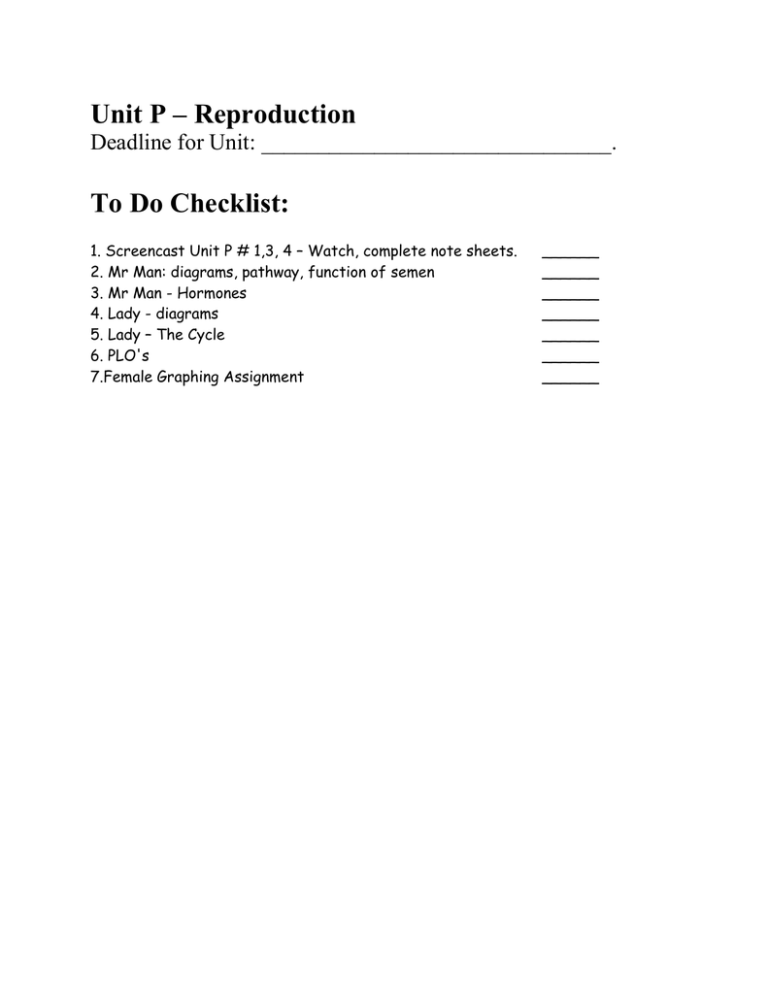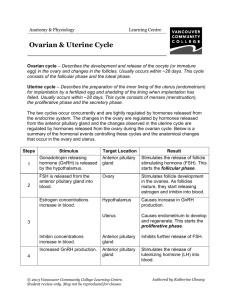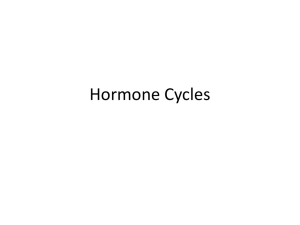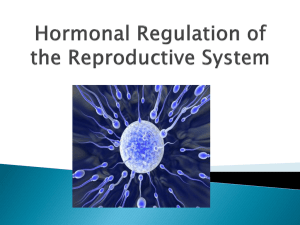File - Mr. Schmitt - Biology 12
advertisement

Unit P – Reproduction Deadline for Unit: _______________________________. To Do Checklist: 1. Screencast Unit P # 1,3, 4 – Watch, complete note sheets. 2. Mr Man: diagrams, pathway, function of semen 3. Mr Man - Hormones 4. Lady - diagrams 5. Lady – The Cycle 6. PLO's 7.Female Graphing Assignment ______ ______ ______ ______ ______ ______ ______ Unit P- Mr Man – Screencast Part 1 Key Ideas 1. 2. 3. 4. Pathway of Sperm Where is it made? Where does it mature? What are the three accessory glands? 1. 2. 3. What is the pathway it follows out of the body? What are the three sections of the sperm? 1. 2. 3. What is the order of the accessory glands? What are the three functions of seminal fluid? 1. 2. 3. Outline the feedback loop for testosterone. Include the anterior pituitary gland, hypothalamus, LH, GnRH, testosterone and the testes. What kind of loop is this? What are the four secondary sex characteristics? 1. 2. 3. 4. What does the LH target? What is produced here? What does the FSH target? What is produced here? Unit P- Female Cycles – Screencast Part 3 Key Ideas 1. 2. What phase of the ovarian cycle is from day 1-13? What is on day 14? What phrase is from day 15-28? What phase of the uterine cycle is from day 1-5? What phrase is from day 6-15? What phrase is from day 16-28? Outline the pathway of an egg/zygote from the ovary until birth. What releases estrogen? What releases progesterone? What two effects do the low levels of estrogen and progesterone have? 1. 2. What two things are maintained when pregnancy occurs? 1. 2. Unit P- Pregnancy and Childbirth Screencast Part 4 Key Ideas 1. 2. How is a zygote created? Where does this happen? What does the zygote attach to? What does the fetus secrete? Levels of what hormones are maintained during pregnancy? 1. 2. What does this prevent? What begins the positive feedback loop in childbirth? Which hormone is released? Male Reproductive System Label the Accompanying Diagram and fill in the functions for each of the following. The structures are (more or less) in order of the path from sperm formation through the male reproductive tract as substances are added to the sperm to produce the final product of semen. Structure Function Testes Scrotum Epididymis Vas deferens Seminal vesicle Prostate gland Cowper’s Gland Urethra Penis The _______________, _____________________, and ________ ________________ are involved in the production of sperm and the conducting it into the urethra. The _________________ ______________, __________________ _________________, and __________________ _____________________ all add contributions (of nutrients or various fluids) to seminal fluid. Male Reproductive System Describe the path of sperm from the seminferous tubules down to the urethral opening. (Flow Chart) Include the glands that add fluids along the way, even though sperm does not pass though them. In Testes Sperm Mature Transport and storage duct End of vas deferens What are the functions of seminal fluid? Label the parts of the mature sperm and give the function of each part. In Penis To Outside Hormone Regulation of Testosterone: 1. Hypothalamus -ultimately controls the testes by secreting __________________-__________________ ___________________. This hormone stimulates the anterior pituitary. 2. Anterior Pituitary -secretes two gonadotropic hormones (in both males and females) - Functions in males: FSH- LH- (also called…. ) All these hormones are involved in a ___________________-feedback relationship. When levels of sperm rise, the hormone ____________ is released which detected by the hypothalamus and anterior pituitary, which turns off their release of GnRH and FSH. This maintains a fairly constant production of sperm. 3. Interstital Cells and Testosterone ____________________ ___________ found in between the semiferous tubules of the __________, produce ___________________. Functions: -development and functioning of male sex organs and sperm -secondary sex characteristics such as : Testosterone production is also regulated by ______________________ - feedback. When LH levels are high they are detected by the hypothalamus, which reduces its release of GnRH. Hormones Hormone Secreting Gland Target Organ Action Female Reproductive System Label the Accompanying Diagram and fill in the functions for each of the following. The structures are (more or less) in order of the path from formation of the egg to removal of the endometrial lining, either by menstruation or childbirth Structure Function Ovaries (follicles and corpus luteum) Oviducts (fallopian tubes) Uterus Endometrium Cervix Vagina Clitoris is an erectile organ, partly enclosed by the labia minora, that is sensitive to stimulation. The clitoris is homologous to the male’s penis, and has a shaft of erectile tissue capped by a pea-shaped gland. It has many sensory nerve receptors which makes it sexually sensitive and is prominent in the processes of female orgasm. The _______________ _____________________, and ________ ________________ contained within the ovary. The _________________ conducts the __________ to the uterus, and is also the site of fertilization. The _________________ is the lining of the uterus, it forms the placenta during pregnancy. If pregnancy does not occur the endometrium breaks down each month and is expelled during menstruation. The endometrium, (or the baby) exits the uterus through the _______________, than through the ______________ to outside the body. Female Reproductive System The Ovary The ovaries produce eggs and the sex hormones estrogen and progesterone. Each month an ovary produces an egg that bursts from the ovary during ovulation. A single follicle actually goes through all stages (1-6) in one place within the ovary. The follicle matures and ruptures to release the egg. The follicle then becomes the corpus luteum which degenerates. Fe m ale Hormones & the menstrual cycle First of all, in order to understand the 28 day menstrual cycle, you need to keep track of what is going on with hormone secretion, the uterus, and the ovaries simultaneously. We will look at the cycle by studying the uterine cycle and the ovarian cycle. These occur simultaneously; so Day 1 of the ovarian cycle is Day 1 of the uterine cycle. The events that occur on Day 1 are different in the ovaries and the uterus. Days 1-14 occur before ovulation and are called the follicular phase. Ovulation typically occurs on Day 14. Days 15-28 occur after ovulation and are called the luteal phase. Day 1 is the first day that menstruation starts. During menstruation, some of the uterine lining, plus a small amount of blood, is shed. However, menstruation is only one event in the menstrual cycle. Let’s look first at the ovarian cycle. The Ovarian Cycle The Ovarian Cycle can be divided into two main phases: o the FOLLICULAR PHASE - when a follicle is developing in an ovary o the LUTEAL PHASE - when a follicle has release its egg and is called the corpus luteum. THE FOLLICULAR PHASE: DAYS 1 - 14 The Highlights! Menstruation occurs, followed a rebuilding of the uterine lining. Increased levels of female hormones follow menstruation. Estrogen predominates. An “LH surge” causes ovulation on day 14. The Details! Days 1 and 5: Ovarian Cycle The female reproductive system is getting ready to repeat the whole cycle once more. The low levels of female hormones is detected by the hypothalamus, causing it to release GnRH. GnRH is sent to the anterior pituitary gland. Remember that GnRH acts on the anterior pituitary gland, making it release the hormones FSH and LH. Uterine Cycle the low levels of female hormones (estrogen, progesterone, FSH, LH, GnRH) cause menstruation. In menstruation, part of the lining of the uterus, plus a small amount of blood, is released through the vagina. The lining of the uterus (also called the endometrium) is at its thinnest at this point. Days 6 to 13: we see increasing levels of FSH and LH. Follow along carefully, because FSH and LH cause different things to happen! Ovarian Cycle FSH stimulates follicle development in the ovary, so as the anterior pituitary gland releases increasing amounts of FSH, this makes a follicle mature and get bigger. Follicles produce the hormone estrogen, so as the follicle matures and gets bigger, it makes more and more estrogen. There is a positive feedback loop involving estrogen, GnRH and LH. As estrogen levels rise, this causes the release of more GnRH, which causes the release of more LH. This is going on between about days 7 to 13. Finally, high levels of estrogen cause the hypothalamus to release a large amount of GnRH, which cause the release of a large amount of LH from the pituitary on day 13. This so-called “LH surge” causes ovulation on day 14. In ovulation, the mature follicle ruptures, releasing the egg from the ovary. The follicle cells stay behind. These remaining follicle cells are called the corpus luteum. Meanwhile, the high levels of estrogen also cause negative feedback on the pituitary to reduce the release of FSH, ending the follicular phase. Uterine Cycle In the ovary, the rising levels of estrogen during days 6 - 13 make the uterus lining get thicker. There is a proliferation in the amount of blood vessels and mucus glands in the lining during days 6 -13. That’s why, in the uterine cycle, this is called the “proliferative phase.” THE LUTEAL PHASE: DAYS 15 - 28 The Highlights! Progesterone predominates. It is released by corpus luteum. Progesterone makes the endometrium double in thickness and secrete mucus. Around about day 25, negative feedback by progesterone on LH causes corpus luteum to start to degenerate, which in turn reduces secretions of progesterone and female hormones, which in turn causes endometrium lining to start to degenerate by about day 28. As luteal phase ends, menstruation begins, and we’re back to day 1. The Details! Ovarian Cycle The corpus luteum (the cells left over from the follicle after the egg has been released) produces increasing amounts of progesterone. It is progesterone that predominates in the luteal phase. Progesterone levels are controlled by a negative feedback loop. When progesterone levels reach their highest levels, negative feedback to the anterior pituitary gland causes the anterior pituitary gland to release less LH. This happens at around the day 24 or 25 stage. Since the corpus luteum requires high levels of LH to maintain itself, as LH levels drop, the corpus luteum begins to degenerate. Since it is the corpus luteum that makes progesterone (it also is producing estrogen), as the corpus luteum degenerates, it makes less and less of progesterone (and estrogen). Uterine Cycle Progesterone makes the endometrium get thicker. It will double in thickness. As the uterine lining is thickening, those mucus glands we mentioned earlier have matured, and begin secreting a thick, mucus material. That’s why this part of the uterine cycle is called the “secretory phase. Recall the corpus luteum begins to degenerate above, so it makes less and less progesterone. Without high levels of progesterone, the endometrium cannot maintain its thickness. It will therefore start to disintegrate by about day 28, and menstruation will once again occur on day 1. The whole cycle will continue to repeat itself until pregnancy occurs or the woman goes through menopause. And now, for a one page summary! The Ovarian Cycle The Uterine Cycle Low levels of ______________ in Low levels of female hormones blood from days 1 - 5. causes ______________ (days 1-5) - endometrium breaks down ______ levels increase from days during days 6 - 13. Days 6 - 13: the rising levels of This causes a ________ to estrogen make the ___________ ________. As follicle matures, it ________ and become vascular & makes more and more _________, glandular (=___________ phase) so estrogen levels ______. High levels of estrogen in blood the ____________ rebuilds itself. causes hypothalamus to secrete a large amount of GnRH, which leads to a ___________ at day 13 which causes _____________ at day 14. Negative feedback by _________ on FSH ends follicular phase. (days 15 - 28) (days 15 - 28) Progesterone makes ____________ double in __________ ___________ makes ___________. increasing amounts of Uterine glands mature and release ________________. thick, _______ secretions. High progesterone causes As corpus luteum ____________, __________ feedback control over anterior pituitary secretions ___________ secretion decreases. of ____, causing _______ _____ This causes ____________ to to degenerate. occur again. As luteal phase ends, ___________ occurs. Female Hormone Levels Estrogen Describe the functions of estrogen: Role in Uterine Cycle: (pg. 424-426) Secondary sex characteristics: Fertilization and Pregnancy While several hundred sperm might make it to the egg, only one will fertilize the egg. The ____________________ of the sperm releases its enzymes which break through the outer layer of the egg. The membranes of the sperm and egg fuse, and the nucleus of the sperm enters the egg. This is the moment of the conception and the new individual is called a zygote. The zygote develops to an embryo as it travels down the oviduct to the __________________. The endometrium is prepared to receive the developing embryo which becomes implanted in the lining, several days following fertilization. The _________________ sustains the developing embryo and the fetus. It is the region of exchange of molecules between fetal and maternal blood, although fetal and maternal blood ____________ mix. The placenta produces _________________ ____________________ ____________________ (____), which maintains the ___________________ _____________________ in the _______________ until the placenta begins to produce its own __________________ and ____________________. Progesterone and estrogen produced by the placenta have two effects: Since the placenta produces progesterone and estrogen, the hormone levels do not fluctuate, so there is no ___________________ during pregnancy. (Recall low levels of both hormones at stimulate menustration). Positive Feedback and Oxytocin While the majority of male and female sex hormones are regulated by negative feedback (turn “OFF” when certain levels are reached), Oxytocin in the female functions by positive feedback. In positive feedback the release of oxytocin from the __________________ _______________, contines to bring about an ever increasing effect, resulting in the release of more __________________ and a stronger effect. Oxytocin is produced in the __________________ and released by the _______________ _______________. Oxytocin has 2 profound effects on the female body: 1. 2. Oxytocin Release During Childbirth Uterine contractions are induced by a stretching of the ______________. This stimulates the release of ______________ from the posterior pituitary. Oxytocin stimulates stronger uterine contractions which pust the fetus downward and stretches the cervix even more causing more __________________ ___ _______________________. This cycle repeats itself until birth occurs. Oxytocin Release During Breast Feeding Oxytocin causes __________ ____________. The more a baby suckles during breast feeding, the more ______________ is released. This is another example of _________________ ___________________. And ONE more time!!! The Ovarian Cycle The Uterine Cycle Days 1 - 5 Days 1-5 Days 6 – 13 Days 6 - 13 Day 14 Days 15 – 28 Days 15 - 28 Hormones Hormone Secreting Gland Target Organ Action







